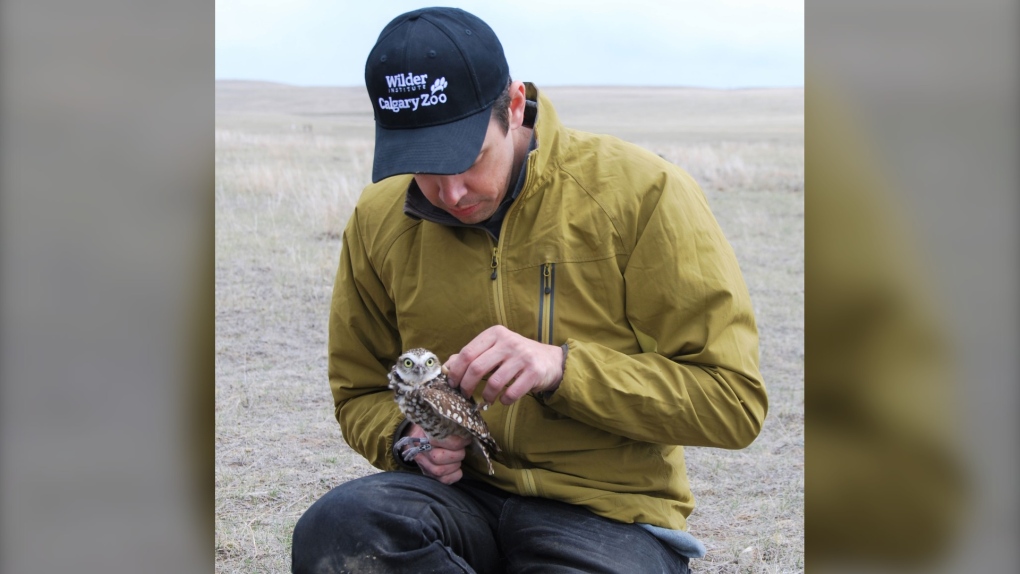Endangered owls, cared for at the Calgary Zoo, now returned to the wild
 Workers with the Wilder Institute/Calgary Zoo will be monitoring the lives of 20 burrowing owls in the wild over the next while to make sure they thrive. (Supplied)
Workers with the Wilder Institute/Calgary Zoo will be monitoring the lives of 20 burrowing owls in the wild over the next while to make sure they thrive. (Supplied)
Zookeepers, who cared for a group of endangered owlets, hope to see the birds mating and laying eggs this season to help bolster Alberta's wildlife population.
Over the past year, staff at the Wilder Institute/Calgary Zoo worked at the facility's Wildlife Conservation Centre (WCC) to raise 20 burrowing owls to give them a head start on a life in the wild.
Without the threat of predators, extreme weather, competition for food and resources, the owls rate of survival has greatly increased, officials say.
"Conservation head-starting is just one piece of a very challenging puzzle," said Graham Dixon-MacCallum, conservation research population ecologist with the Wilder Institute/Calgary Zoo, in a release.
"We know that burrowing owls still face threats in their grasslands habitat, but thanks to this important collaborative effort there are more owls in the wild to regain a foothold in the province."
Staff members that worked with the owlets say they were "lucky" to be a part of their lives.
"It's fantastic to see the progress they have made here at the WCC," said Colleen Baird, senior manager of animal care with the Animal Care, Health, & Welfare team at the Wilder Institute/Calgary Zoo.
"We want to make sure that the owls are equipped to overcome challenges in the wild. Our team of veterinary, animal care, and conservation research experts work together to ensure the owls are healthy and have excellent body condition."
The Prairies are where Canada's burrowing owl population makes their home and habitat loss, climate change and other environmental changes have led to their decline.
"Canada's burrowing owls have seen a more than 90 per cent decline in their population over the last 40 years and are still facing significant threats. One of the many factors that limit their population from growing is the low survival rate of owlets hatched in the wild," the zoo said.
Now that they are free in the Canadian grasslands, the owls are able to nest in secure burrows installed by team members and equipped with a netted enclosure.
They will also be provided food at the location until they lay eggs of their own.
CTVNews.ca Top Stories

Outdated cancer screening guidelines jeopardizing early detection, doctors say
A group of doctors say Canadian cancer screening guidelines set by a national task force are out-of-date and putting people at risk because their cancers aren't detected early enough.
Lululemon unveils first summer kit for Canada's Olympic and Paralympic teams
Lululemon says it is combining function and fashion in its first-ever summer kit for Canada's Olympians and Paralympians.
'I just started crying': Blue Jays player signs jersey for man in hospital
An Ontario woman says she never expected to be gifted a Blue Jays jersey for her ailing husband when she sat alone at the team’s home opener next to a couple of kind strangers.
Mussolini's wartime bunker opens to the public in Rome
After its last closure in 2021, it has now reopened for guided tours of the air raid shelter and the bunker. The complex now includes a multimedia exhibition about Rome during World War II, air raid systems for civilians, and the series of 51 Allied bombings that pummeled the city between July 1943 and May 1944.
LIVE @ 4 EDT Freeland to present 2024 federal budget, promising billions in new spending
Canadians will learn Tuesday the entirety of the federal Liberal government's new spending plans, and how they intend to pay for them, when Deputy Prime Minister and Finance Minister Chrystia Freeland tables the 2024 federal budget.
B.C. woman facing steep medical bills, uncertain future after Thailand crash
The family of a Victoria, B.C., woman who was seriously injured in an accident in Thailand is pleading for help as medical bills pile up.
Step inside 'The Brain': Northern education tool aims to promote drug safety
An immersive experience inside a massive dome coined 'The Brain' is helping youth learn about brain function and addiction
WATCH Half of Canadians living paycheque-to-paycheque: Equifax
As Canadians deal with a crushing housing shortage, high rental prices and inflationary price pressures, now Equifax Canada is warning that Canadian consumers are increasingly under stress"from the surging cost of living.
Ontario woman charged almost $7,000 for 20-minute taxi ride abroad
An Ontario woman was shocked to find she’d been charged nearly $7,000 after unknowingly using an unauthorized taxi company while on vacation in January.

































